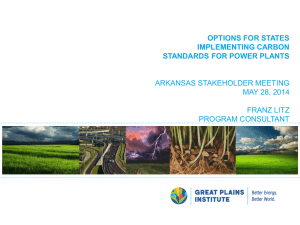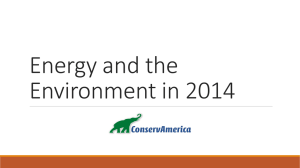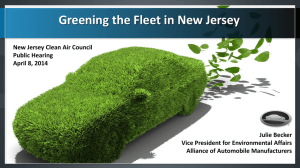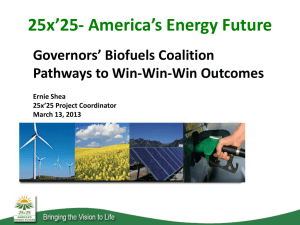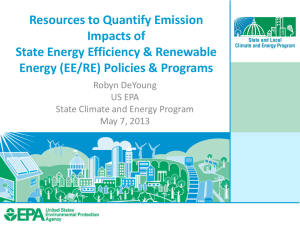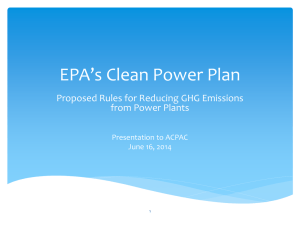Litz_NDARE_111d_Briefing_1
advertisement
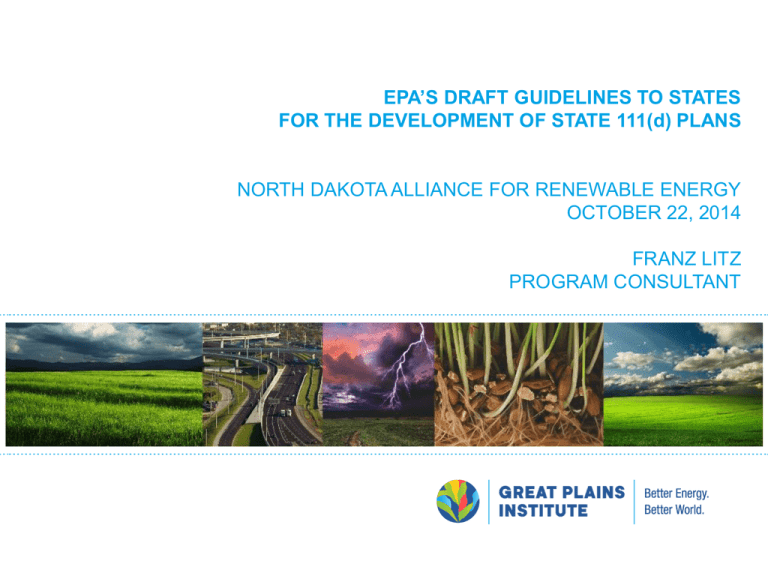
EPA’S DRAFT GUIDELINES TO STATES FOR THE DEVELOPMENT OF STATE 111(d) PLANS NORTH DAKOTA ALLIANCE FOR RENEWABLE ENERGY OCTOBER 22, 2014 FRANZ LITZ PROGRAM CONSULTANT Overview of Presentation • • • • • 111(d)’s Federal-State Framework Building Blocks “build” state stringency Beyond EPA’s “Building Blocks” Planning under §111(d): the Approaches “No Regrets” Exploration of Options The Federal-State Framework • EPA issues standards for new sources--under §111(b) of the Clean Air Act—and these are federal. • For existing sources, EPA issues guidelines to states under 111(d) to “guide” states on 111(d) plans. • States develop 111(d) plans—single-state or multi-state. • If state fails to submit plan, or the plan is inadequate, EPA imposes federal plan 3 Summary of EPA 111(d) Guidelines • Dubbed EPA’s “Clean Power Plan” • Sets minimum stringency for a state—called “state goals” that apply in aggregate to the state’s “affected” electric generating units • Establishes a compliance time period of ten years, with an interim target to apply on average between 2020 and 2029, and a final target in 2030 • Guidelines give states very broad flexibility to achieve state goals through any “efficacious means” 4 “Adjusted Output-Weighted Average CO2 Emission Rates” TOTAL CO2 EMISSIONS from Coal-, Oil- & Gas-fired Steam, Natural Gas Combined Cycle & “Other” Units (Affected EGUs) TOTAL NET ENERGY OUTPUT From Affected EGUs + Renewables + New Nuclear + 6% at-risk nuclear + cumulative annual EE savings Lbs MWh Or Convert the Goal to Tons. BUILDING BLOCKS Heat Rate Improvements at Coal Plants 6% through both O&M and plant upgrades Increased Utilization of Existing Natural Gas Plants Dial up existing NGCC to 70% capacity factor Increased Utilization of Zero Carbon Resources, Including Nuclear and Renewables Operate New Nuclear Plants, Preserve the 6% of Existing Nuclear capacity that EIA projects would retire; & Achieve renewables generation consistent with average regional renewables target Achieve 1.5% Energy Savings through End-Use Energy Efficiency Starting where a state is, increase energy savings at a rate of 0.2% per year until state reaches 1.5% BUILDING BLOCKS Are NOT a Compliance Pathway • EPA has not provided a compliance pathway—not really. That is left to each state, or to states working together. BEYOND THE BUILDING BLOCKS Heat Rate Improvements at Coal Plants Increased Utilization of Existing Natural Gas Plants Increased Utilization of Zero Carbon Resources, Including Nuclear and Renewables Achieve 1.5% Energy Savings through End-Use Energy Efficiency Co-firing lower carbon fuels Retirements New Natural Gas Plants Distributed Generation, Combined Heat and Power Carbon capture & storage (e.g. EOR-related) Gains from Trade/Regional Compliance EPA’s Draft Guideline to States • EPA says “YES” to broad flexibility for states— “any efficacious means” • Too many choices? Maybe not at closer look: – Federal enforceability issues make “portfolio” approach undesirable to many states; – Fewer regulatory hoops to jump through with direct emissions limitations on affected units; – Self-correcting compliance plans do not require milestones or corrective measures; and – Direct emissions limitations keep open the option for connecting a state’s plan to other states. 9 Possible Approaches • Approaches getting most consideration to date include: ①Traditional plant-level performance standards; ②Mass-based emissions budget with trading; ③Rate-based standard with trading; or ④Mass-based utility budget approach. 10 Mass-based Budget with Trading The Approach • State converts rate-based goals to mass-based emissions budget. • State issues allowances (or permits) to emit. (1 ton = 1 allowance) • Power plant owners report emissions and must turn in enough allowances to “cover” all of the plant’s emissions on a set date. • Value of allowance becomes part of generator’s bid to ISO. Issues to Consider • Direct emissions limits on affected units; no need to regulate other entities. • EE, RE programs are complementary and remain separate and not federally enforceable. • Multi-state cooperation possible by recognizing other states’ allowances. • Self-correcting mechanism, meaning no need to specify “corrective measures”. 11 Rate-based Standard with Trading The Approach • State follows emissions rates imposed by EPA, or some variation designed to meet federal goal: • Plants that do better than the rate generate credits that can be sold to other plants; and • Plants that do worse than the rate must purchase credits to improve their emissions rate. • Can credit EE & RE through crediting mechanism. Issues to Consider • To credit EE & RE, a federally enforceable mechanism needed for EM&V and crediting. • Can avoid federal enforceability over RE & EE programs. • May not capture all improvements to carbon profile that a mass-based standard would—such as retirements. • Self-correcting approach, so no need to specify “corrective measures” 12 Mass-based Utility Budget Approach The Approach Issues to Consider • State converts rate-based goal to mass-based “budget”. • State apportions budget to utilities. • To stay under budget, each utility can undertake any measures in its control: • As long as this approach places all obligations on utility owner/operator of affected units, this is a direct emissions limitation approach and “corrective measures” not necessary. • No need to have EE/RE crediting because reductions appear automatically. • Multi-state utilities may want multi-state coordination to allow tons to cross state lines. • • • • • • • Plant-level heat-rate improvements; Fuel switching; Retirements; End-use energy efficiency; Preserve Nuclear; Carbon capture & storage/EOR; and/or Renewables. 13 State Planning Timeline • Comments on Draft Rule due Dec 1st • Final Rule Expected June 2015 • State plan timing: – Initial state “submittal” in June 2016 – One-year extension possible for adopting single-state plans – Two-year extension possible for adopting regional plans • Programs go into effect upon adoption of state plans, unless superseded by federal plan Quick Summary ① EPA’s guideline sets stringency based on “building blocks”, does not dictate how states are to comply ② States will decide on approach for achieving stringency ③ What seems like a case of “too many choices” probably isn’t—states and stakeholders usually end up with a short list of options 15 Pause Here Midwestern Power Sector Collaborative • Group of coal-based utilities, coops, merchant and municipal generators, plus state officials & advocates • Working together to understand and shape a Midwestern response to EPA actions • Joint, consensus-based comments filed before the draft, and now working on joint comments to EPA on the draft Midwestern Collaborative Participants • Industry folks: – – – – – – – – – – Alliant Basin Electric (observer) DTE Energy Great River Energy MidAmerican NRG WeEnergies Wolverine Power Coop Wisconsin Public Power Inc. Xcel Energy • State folks: – IL Commerce Commission – – – – – Kentucky Energy Cabinet Michigan DEQ & PSC Missouri PSC Wisconsin PSC & DNR Wisconsin DNR • Advocates: – – – – – – – – Clean Air Task Force Clean Wisconsin Environmental Defense Fund Iowa Environmental Council Michigan Ecology Center MN Ctr for Energy & Env Ohio Environmental Council Union of Concerned Scientists Multistate Collaboration • Why collaborate? • “Gains from trade” make achieving goals easier region-wide. • States with excess or lower cost reductions can sell those to other states, making it a “win-win”. • Reliability of the electricity system—if something happens in one state to make compliance harder, the state can rely on options in other states. • Lessen competitiveness issues between states. • Regional wholesale electricity markets/power pools & multi-state utilities • The effects of measures to reduce emissions often appear outside the state, as with RE purchased from outside the state. • Comparative advantage—each state does what it does best (or most cost-effectively). 19 Issues for Multi-State Compliance • Each state is a sovereign entity • There is no regional government, only federal and state— • Enforceable obligations between states may trigger the Compact Clause of the US Constitution, requiring congressional approval. • Would any state want to make their 111d plan enforceable by another state? • Not necessary to create new legal structures—the ones we have can work— • • Need on-ramps, because different states will have different pathways and timeframes for decision; and May need off-ramps, because a state may change its mind. • A state can develop a plan that is “multi-state ready” and keep its options open. 20 The “No Regrets” Path • States can prepare individual state plans while also exploring regional or multi-state cooperation. • In devising state plans, states can consider designs that keep the regional/multi-state pathway open. For example, a common currency such as an emissions reduction credit or an emissions allowance. • Ultimately linking up with others is a political decision to be made by governors, legislatures— • In the meantime, multistate collaboratives allow states to pool resources and better understand options. 21 THANK YOU! FRANZ LITZ PROGRAM CONSULTANT flitz@gpisd.net


